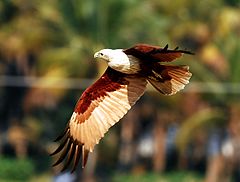Haliastur
Wygląd
| Haliastur[1] | |||
| Selby, 1840[2] | |||
 Przedstawiciel rodzaju – kania bramińska (H. indus) | |||
| Systematyka | |||
| Domena | |||
|---|---|---|---|
| Królestwo | |||
| Typ | |||
| Podtyp | |||
| Gromada | |||
| Podgromada | |||
| Infragromada | |||
| Rząd | |||
| Rodzina | |||
| Podrodzina | |||
| Plemię | |||
| Rodzaj |
Haliastur | ||
| Typ nomenklatoryczny | |||
|
Falco pondicerianus J.F. Gmelin, 1789 (= Falco indus Boddaert, 1783) | |||
| Synonimy | |||
|
| |||
| Gatunki | |||
| |||
Haliastur – rodzaj ptaków z podrodziny jastrzębi (Accipitrinae) w rodzinie jastrzębiowatych (Accipitridae).
Zasięg występowania
[edytuj | edytuj kod]Rodzaj obejmuje gatunki występujące w Azji i Australazji[9][10].
Morfologia
[edytuj | edytuj kod]Długość ciała 44–59 cm, rozpiętość skrzydeł 110–146 cm; masa ciała 380–1100 g; samice są większe i cięższe od samców[9].
Systematyka
[edytuj | edytuj kod]Etymologia
[edytuj | edytuj kod]- Milvulus: rodzaj Milvus Lacépède, 1799 (kania); łac. przyrostek zdrabniający -ulus[11]. Gatunek typowy: Milvus rotundicauda Hodgson, 1836 (= Falco indus Boddaert, 1783); młodszy homonim Milvulus Swainson, 1827 (Tyrannidae).
- Haliastur: gr. ἁλι- hali- „morski”, od ἁλς hals, ἁλος halos „morze”; łac. astur, asturis „jastrząb”, gr. αστεριας asterias „jastrząb”, od αστηρ astēr, αστερος asteros „gwiazda”[11].
- Dentiger: łac. dens, dentis „ząb”; -ger „noszenie”, od gerere „nosić”[11]. Gatunek typowy: Falco pondicerianus J.F. Gmelin, 1789 (= Falco indus Boddaert, 1783)
- Ictinoaetus: rodzaj Ictinia Vieillot, 1816; gr. αετος aetos „orzeł”[11]. Gatunek typowy: Milvus sphenurus Vieillot, 1818.
- Milvaquila: zbitka wyrazowa nazw rodzajów: Milvus Lacépède, 1799 (kania) oraz Aquila Brisson 1760 (orzeł)[11]. Gatunek typowy: Falco indus Boddaert, 1783.
- Halinertus: gr. ἁλι- hali- „morski”, od ἁλς hals, ἁλος halos „morze”; νερτος nertos „rodzaj jastrzębia”[11]. Nowa nazwa dla Haliastur Selby, 1840 ze względu na puryzm.
- Ictiniastur: gr. ικτιν iktin lub ικτινος iktinos „kania”; rodzaj Astur Lacépède, 1801 (jastrząb)[11]. Gatunek typowy: Milvus sphenurus Vieillot, 1818.
Podział systematyczny
[edytuj | edytuj kod]Do rodzaju należą następujące gatunki[12]:
- Haliastur sphenurus (Vieillot, 1818) – kania złotawa
- Haliastur indus Boddaert, 1783 – kania bramińska
Przypisy
[edytuj | edytuj kod]- ↑ Haliastur, [w:] Integrated Taxonomic Information System (ang.).
- ↑ P.J. Selby: A Catalogue of the generic and sub-generic types of the class Aves arranged according to the natural system, with separate lists, distinguishing the various quarters of the globe in which they are to be procured. Newcastle: 1840, s. 2, 3. (ang.).
- ↑ B.H. Hodgson. Summary Description of Some New Species of Birds of Prey. „The Bengal Sporting Magazine”. 8 (28), s. 183, 1836. (ang.).
- ↑ B.H. Hodgson: Catalogue of Nipalese Birds, collected between 1824 and 1844. W: J.E. Gray: The zoological miscellany: to be continued occasionally. London: Treuttel, Wurtz and Co., G.B. Sowerby, W. Wood, 1831–1844, s. 81. (ang.).
- ↑ J.J. Kaup: Classification der Säugethiere und Vögel. Darmstadt: C.W. Leske, 1844, s. 122. (niem.).
- ↑ C.H.C. Burmeister: Verzeichnis der im zoologischen Museum der Universität Halle-Wittenberg aufgestellten Säugethiere, Vögel und Amphibien. Halle: W. Plötz, 1850, s. 24. (niem.).
- ↑ F. Heine & A. Reichenow: Nomenclator Musei Heineani Ornithologici; Verzeichniss der Vogel-Sammlung des Kgl. Oberamtmanns Ferdinand Heine. Berlin: R. Friedländer & Sohn, 1882–1890, s. 267. (niem.).
- ↑ G.M. Mathews: The Birds of Australia. Cz. 5. London: H.F. & G. Witherby, 1915–1916, s. 146. (ang.).
- ↑ a b D.W. Winkler, S.M. Billerman & I.J. Lovette: Hawks, Eagles, and Kites (Accipitridae), version 1.0. W: S.M. Billerman, B.K. Keeney, P.G. Rodewald & T.S. Schulenberg (red.): Birds of the World. Ithaca, NY: Cornell Lab of Ornithology, 2020. DOI: 10.2173/bow.accipi1.01. [dostęp 2020-06-04]. (ang.).

- ↑ F. Gill, D. Donsker & P. Rasmussen (red.): Hoatzin, New World vultures, Secretarybird, raptors. IOC World Bird List (v11.1). [dostęp 2021-04-05]. (ang.).
- ↑ a b c d e f g Etymologia za: James A. Jobling: The Key to Scientific Names. [w:] Birds of the World [on-line]. Cornell Laboratory of Ornithology, Ithaca, NY, USA, 2021. (ang.).
- ↑ Systematyka i nazwy polskie za: P. Mielczarek & M. Kuziemko: Plemię: Accipitrini Vigors, 1824 (wersja: 2019-03-24). [w:] Kompletna lista ptaków świata [on-line]. Instytut Nauk o Środowisku Uniwersytetu Jagiellońskiego. [dostęp 2020-06-04].
